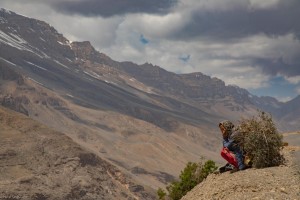A slow drive over 6 days with stops on the lower Himalayas from the arid and hot plains of Gurgaon, Rabab and I thought, would help us acclimatize to the oxygen-scarce air in high altitude Spiti. However, on reaching Nako at 11,000 feet, the last village in Kinnaur district in Himachal Pradesh before one enters Spiti, every few steps left us breathless, with a pounding heart wanting as if to burst from the chest. The villagers sailed past us with ease on our walks – ‘Jule!’ - as we stood beached watching them pass, their bodies clearly able to make the most of the thin air. This was a sign we plains, city people were entering a very different world.
 Key Gompa. Spiti
Key Gompa. Spiti
Lahaul & Spiti became part of Himachal in 1966 with the reorganization of Punjab on linguistic lines, and Haryana split off. This was the period China claimed all of the Himalayan foothills in India as part of its district of Tibet due history and cultural and ethnographic affinity. There is some truth in this claim, and I am so glad it didn’t work out for China the way they wanted.
The high Himalayas of Spiti at an altitude 11,000 feet and above are broken by deep valleys where the rivers from ice and snow-melt flow in a gentle incline to the plains and merge with the Sutlej and onto the ocean. There is only the sound of vast silence on the mountains and, occasionally, the rushing wind. In the narrow river valleys, there is fast-flowing water. There are almost no trees on the mountains, other than those along the riverbanks. Mostly rock and bare soil is all that is visible on the mountain sides. The sky is a brilliant blue dotted by clouds that don’t rain. The land and the sky merge into one on the horizon, the blue of the sky mirrored in the river. The air is so clean it hurts to breathe. Upside down world.
People are singularly absent. Villages are at a great distance from each other and are sparsely populated. Spiti has only 2.3 people per square kilometer (Uttar Pradesh has 800, Delhi has 11,000. Really.). It will yet take time for my Indian plains gaze to acclimatise to so few people, and by then it will be time to return to the press of human bodies and noises from machines. People here are acclimatised, over millenia, to hold on to the stillness. Their practice of Tibetan Buddhism, mixed with ancient nature worship, merges well with their harmonious co-existence with nature. There is varied animal and bird life startlingly surprising to find at this height and ecology, though it is sparse and therefore a joy when spied. All this combines, as one travels through the land and its people, to invite a warm settling of solitude. Quite contrary to loneliness, this is a peace only these high mountains bring.
 The Spiti Tangrol
The Spiti Tangrol
Nako was till recently a quiet village comprising a few score homes constructed in the traditional style and famous for its ancient Buddhist Gompa (monastery) from the 10th Century CE. The village now hums with the sounds, sights and coming wealth of development. Vigorous construction of numerous homestays in narrow village lanes is underway. Traditional aesthetics and architecture have been thrown to the wind. Hundreds of tourists from the plains pass through for a quick night or two, and scores of motor vehicles clog the lanes and park in areas once occupied by cattle. This wrenching change is a product of the last few decades, as everywhere in India, which has gathered pace in Nako in the last 5 years. Nako village and its holy lake nestled in a valley remain picturesque. We cannot know for how long.
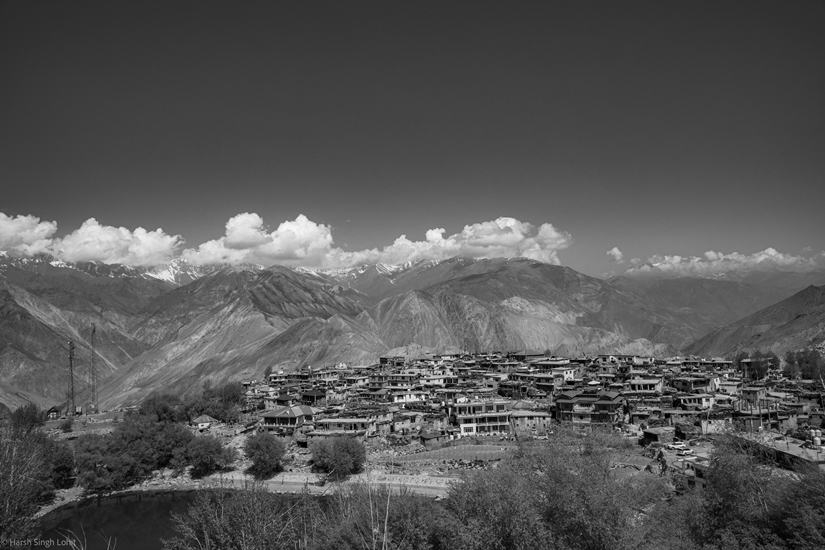 Nako village
Nako village
The village has numerous homes and community buildings constructed in the traditional style: rammed earth, wood-branches, grass of multiple kinds, and stone. These are painted with a local white mud and limestone and ochre mud in the characteristic style of Spiti and Ladakh. The homes have a flat roof, as there is no to very little rain in these parts, and the snow on the roof in winter is quickly cleared before it melts and causes lasting damage. My admiration for traditional construction and its ingenuity of our ancestors isn’t just romance. Local style and materials are so much more aesthetically appealing, besides their seamless integration with the local ecology. These homes use local materials that are not produced by intense application of fossil energy (unlike cement, steel, and glass), do not need long distance transportation on motor vehicles, are mostly inexpensive and abundant, use expert local skills (architect, mason, carpenter, labor) available within a cluster of nearby villages, and have evolved into this architecture over hundreds if not thousands of years of incremental, successful experimentation.
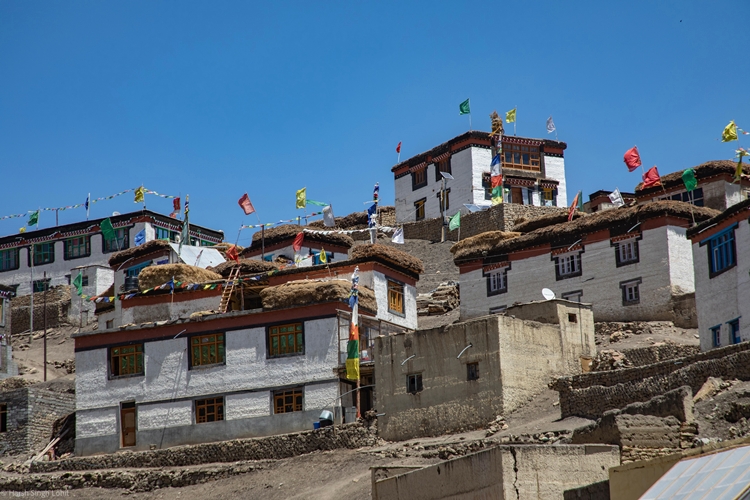 Traditional homes in Lingzay
Traditional homes in Lingzay
Society does not incorporate ancient traditions with the modern. Architecture – like agriculture - today exhibits a wholesale rejection of local genius in favor of materials and methods created in different cultures and singularly unsuited to our climates. Certainly, cement can have its uses in Spiti. It can be used in seamless integration with mud construction. It can be used, for example, to replace the wooden beams that are now unavailable to meet the demands of a growing population. The market, however, demands a complete surrender. Private corporations produce cement in enormous and ever-increasing quantities and make it available across the country through their wide and growing supply network all the way till and beyond Spiti. Convenience trumps sustainability, no matter how much one is willing to compromise. It is all or nothing.
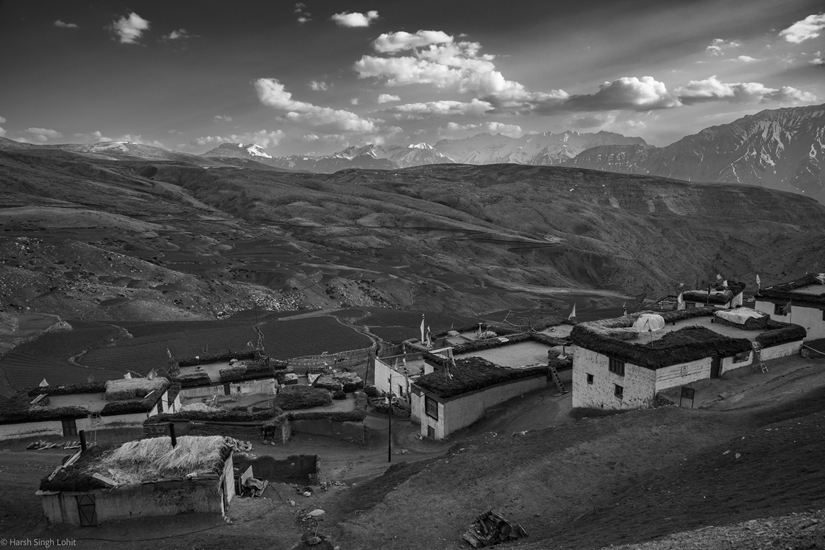 Hikkim Village
Hikkim Village
The drive from Nako to Kaza, headquarters of Spiti and a large village, was breathtaking. We stopped along the way to rid ourselves of the industrial sound of our vehicle, to stretch limbs restricted by the long sitting, and to absorb the silence. This desert high up in the Himalaya is like the mythical tree with its roots in the air, a topsy turvy world. The stark beauty of the treeless mountain ranges that rise far higher than the 11,000 feet we generally drove on continued unbroken.
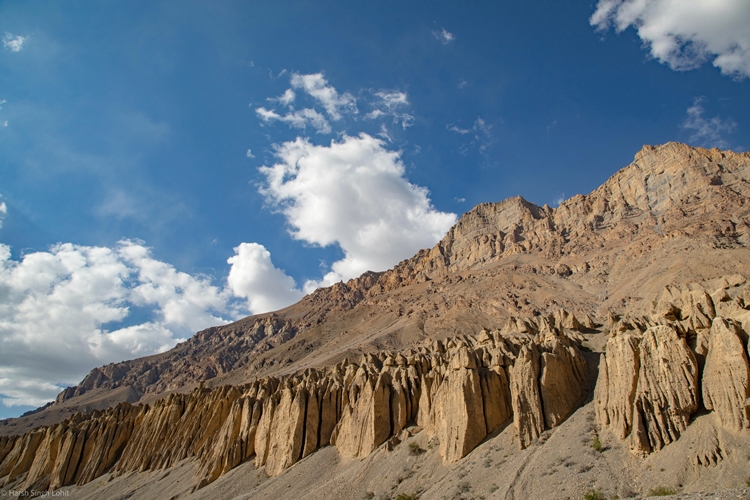 Mountains of Mud
Mountains of Mud
The natural environment of Spiti presents enormous difficulties for human settlement and its expansion, thus keeping unbridled economic development in check. The thin air, the extreme cold and snow, absence of agriculture in other than the river valleys keep outsiders away, the narrow winding roads and challenges to mass transport retain a tight bridle on runaway human activity. The locals are severely challenged by the winter and economic activity shuts down and a major objective is waiting out the cold and snow. Nature is visible and omnipresent, people go about their lives with a respect for mountains, rivers and animal life that is singularly missing in the city and in the populated villages of the north Indian plains I was born into. India’s diverse ways of life from ancient times held exactly such an awe and respect for Prakriti, rooted in ashrams, kutirs, guru’s who lived in what were once vast Vanya and jungles. With the acceleration of a globalised modernity, this ‘victory’ of human effort over nature has mostly eliminated this respect for nature.
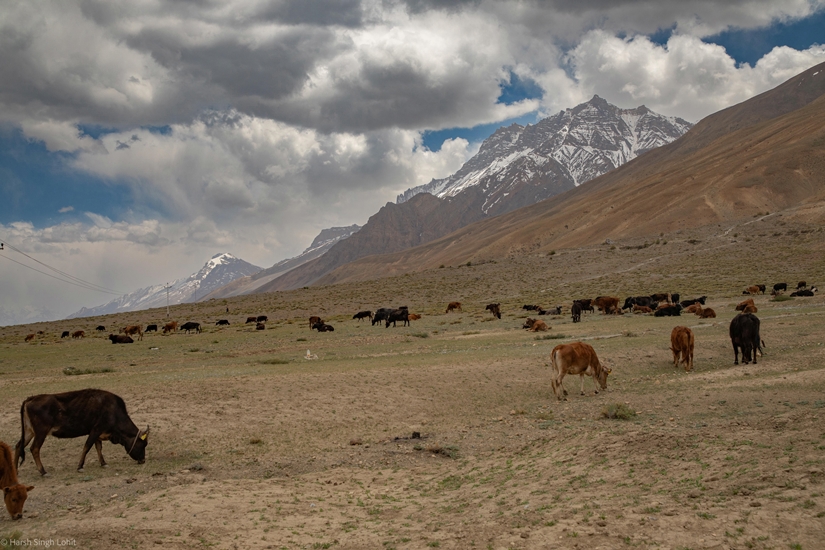 Summer Pasture near Hull village
Summer Pasture near Hull village
The cold waters of the Spiti river turn alternately muddy and a transparent, stunning turquoise due to the changing pace of the melt of the glaciers and snow that feed the river. This is early May, summer for the locals and cold for us, 25 degrees in the day and 5 degrees in the night with sharp winds. The sun is disconcertingly strong by mid-day at this altitude, responsible for the ruddy cheeks of the Spitians and our chapped lips and burnt skin.
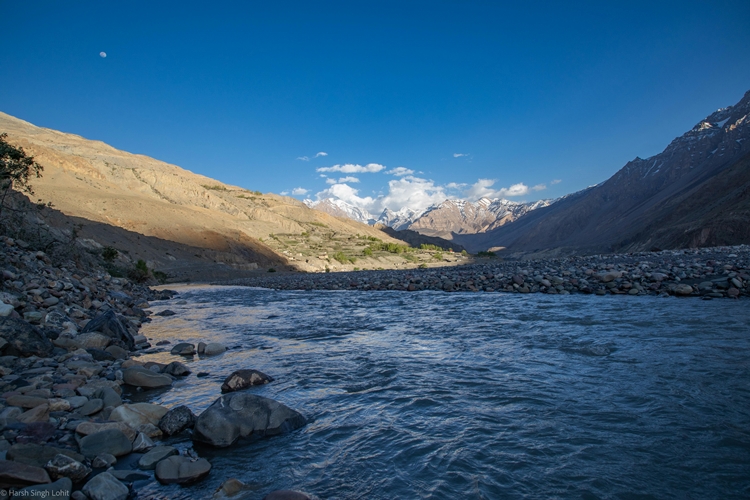 Spiti River
Spiti River
The 1961 district survey of Lahaul & Spiti stated with a finality ‘there is no urban area in the district’. This is true today too, and Kaza remains a village albeit a large one. It boasted a population of 310 then, and it now it is up tenfold to 3,200. Spiti’s isolated inaccessibility since then has been punctured by a widespread network of all-weather roads that enable development and the movement of the army, bringing modernity’s attendant benefits and problems. Kaza’s infrastructure for managing the detritus of modern life hasn’t kept pace with the growth of its population and the immense increase in the flow of tourists. Haphazardly constructed concrete homes, plastic, packaging of food and snacks, motor vehicles pollute and crowd this once picturesque village. The warming of the global climate is real here, the receding Himalayan glaciers - crucial to life in the Indian plains - are a living history in sight.
We stayed at hotel Deyzor, a most wonderful small hotel. Karanbir and Kim, the energetic youth who run this warm and inviting place, are intrepid global travelers and citizens. They have established this easy place in their own image, with an efficient, welcoming, informal atmosphere and the most amazing food and rooms. Our first visit is to the village fields below Key Gompa, 40 minutes away. Its sowing time for black peas, a cash crop, and all the women in every village where there is agriculture are busy de-weeding and irrigating the crop.
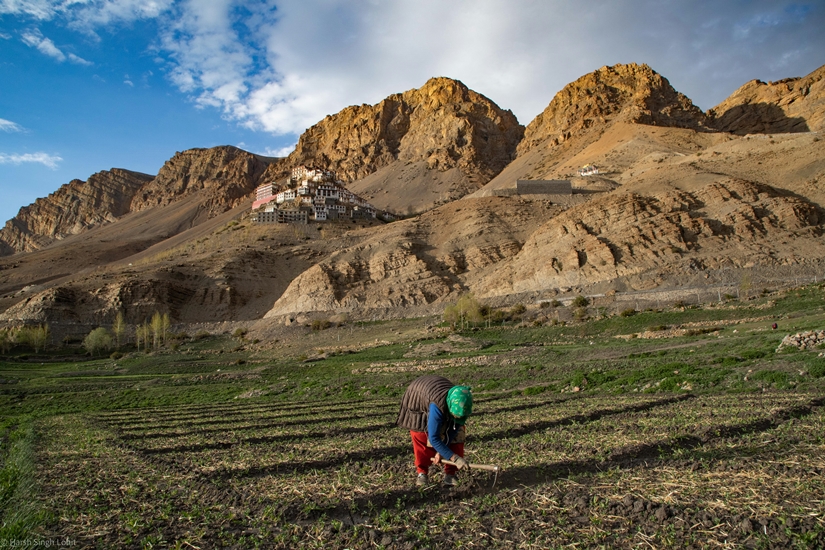 Pea Farming in Key Village
Pea Farming in Key Village
The China war and the resultant unfortunate military tensions between our nations all but eliminated trade across the long land border with Tibet. Trade was always a critical part of Himalayan life for millennia, exchanging ideas, religion and goods across a borderless land with a common culture. Tibet is now an unreachable land. Nothing has ever made up for this tremendous loss of connection. People in Spiti now consume tinsel religious offerings made in Majnu ka Tila, the teeming Tibetan settlement in Delhi, and from the rest of India.
Farmland is less than 0.002% of the total land area of Spiti, a miniscule part of its 2.5 million acres. Village women work at multiple tasks in agriculture and cattle rearing, the men generally travel out of the village for daily wages and some help with farming in the brief growing season from April to October. As there is no rainfall in Spiti, agriculture depends on irrigation from small canals called Kuhls that direct water from a nearby river to the terraced farming land in an act of innovative engineering. The soil is sandy loam, healthy and productive and everything grows wondrously without chemical fertiliser. Yet.
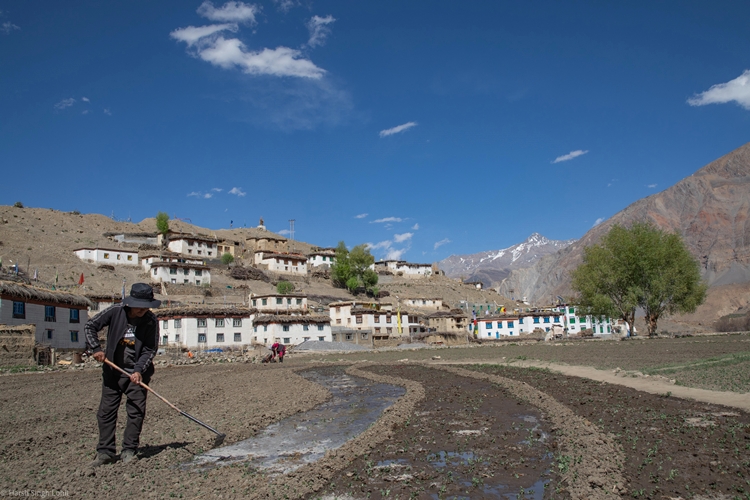 Irrigating at Mane
Irrigating at Mane
We spent the next ten days with Lobzang, our young and indefatigable guide, exploring the land, people and culture from her sympathetic eyes. An entrepreneur who runs a two-room homestay in the quaint village of Mane, Lobzang also farms, works with Karanbir on collecting local food produce and cloth for sale to tourists, guides tourists, is a great storyteller, and at 34 is a mother of two young men a testimony to her early wedding.
We often crossed collections, along the road, of Mane prayer stones that are ubiquitous wherever Tibetan Buddhism holds sway. Each is placed by a villager, usually with the shloka Om Mane Padme Hum carved by a village craftsman in winter when everyone is homebound. Conveniently set-up along the road as a walled structure, people and vehicles circumambulate this for good karma. The smooth riverine stones lie juxtaposed with the craggy mountains, in harmony with nature. A stillness continues to settle.
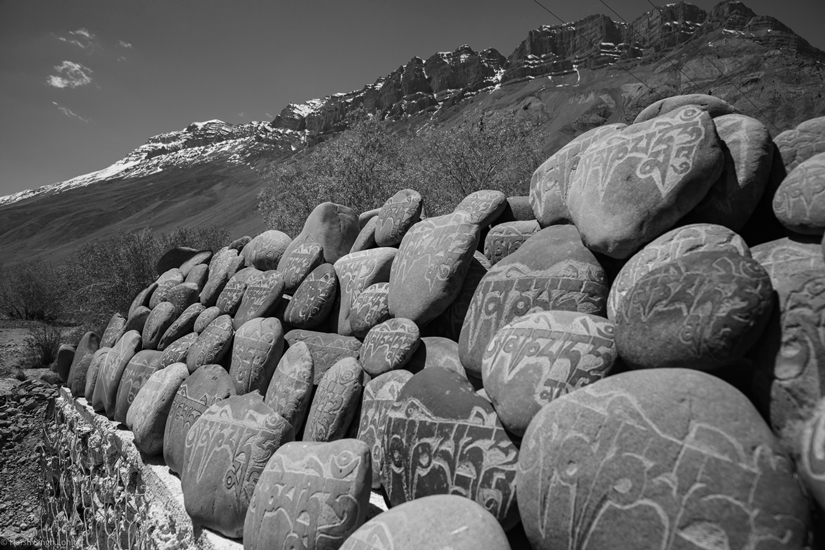 Mane Wall on route Mane village
Mane Wall on route Mane village
Thousands of tourists, specially from the nearby states of Punjab, Haryana and Uttar Pradesh, visit Spiti in increasing numbers between May and November. I think they generally hold a culturally insensitive gaze while here, with little interest in the real lives of the locals. Most pass through for a brief few days to see the well-advertised attractions on the limited tourist circuit, looking curiously at exotic monasteries. Many tourists look for basic accommodation, dal-roti and alcohol. Kaza has scores of homestays of which many are little more than cramped dormitories that don’t look like they enhance the experience of the local. Kaza is already polluted and crowded way beyond its carrying capacity, and the slow pace of life I witnessed as recently as 2007 when I stayed at then at its only hotel has disappeared.
Mane village is unfrequented by mass tourism and will remain thus. As we strolled through the quiet village, Lobzang pointed out a 300 year-old home in traditional mud architecture that the owner wants to restore and convert to a small homestay. We sat peacefully in the ancient village Lakhang, a small Buddhist place of worship; walked down to the fields in the valley to see women busy de-weeding and irrigating the pea crop, watched over by Chortens; infants sleeping peacefully in the shade of the trees as mothers toiled; and older children playing on the land. Everybody knew everybody, and they chattered away as peasants tend to do. The best part of our visit, though, was black peas, thentuk (wheat pasta with vegetables) and thukpa(wheat noodle soup with vegetables). And of course dal-chawal.
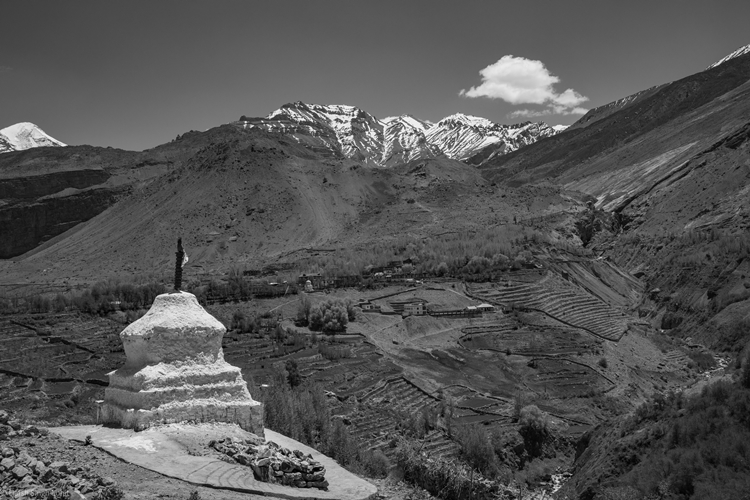 Chorten overlooking Mane village
Chorten overlooking Mane village
Fluent in Hindi, Lobzang had many stories to share from her brief 34 years. Her stories reached back into her childhood in Hull village when manual chores were part of daily life lived in the wide-open spaces. After marriage and moving to Mane, she walked hours each way to reach her farm plot ‘across the mountain’, carried loads and water up and down the mountains on her own and on the back of donkeys in the snowed-under winters, walked across the mountains to gather branches from bushes used for the roofs, came across surprised snow leopards face-to-face when the cat bounded away after a good look at the frozen young woman. Another day, we walked further down the valley to the quick, rushing Mane stream and came across young students returning from the village school on the next mountain. They have an idea of the beauty they are immersed in, though a full realization is yet years away. Prakriti is inside their home, school and commute - it engulfs them, omnipresent. No antiseptic modern home, workplace, college or mall for anyone here.
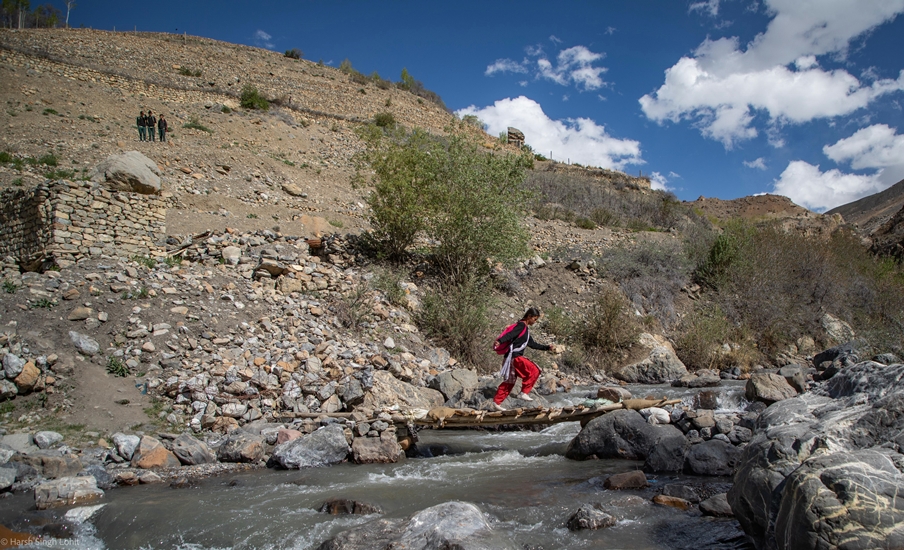 School Commute, Mane
School Commute, Mane
The next day was at Tashigong in a small Chokhang in a tantric Chowa’s home. He gets the rare visitor and is an eccentric man. His hospitality, though, was undiminished by his solitude as he insisted on serving us many helpings of Sampa (roasted Jau or barley sattu) with thick Sho yogurt (from milk of dino yak) and spoonful’s of sugar. What is it about those who don’t nearly have materially enough, but possess a heart enormous enough to welcome strangers to share their home-grown meal? This tasted amazing, as you can well imagine.
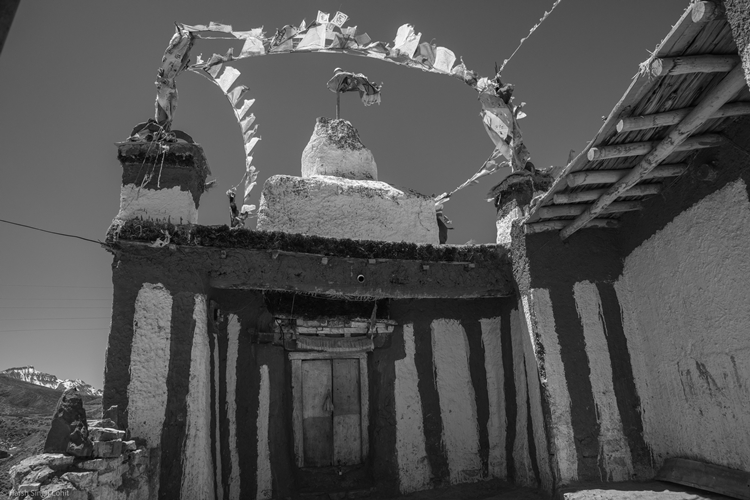 Tashigong
Tashigong
We drove past trees of juniper, pine, willow, poplar and spruce growing singly and in groves along the river valleys. And rhododendron bushes from which herbal tea is made, excellent for health - I couldn’t quite get used to the strong flavour. Wild grasses for cattle fodder grow along the rivers and fields, as also the bushes and other grass on the mountain sides that are used in constructing one of the layers on the roofs of the mud houses.
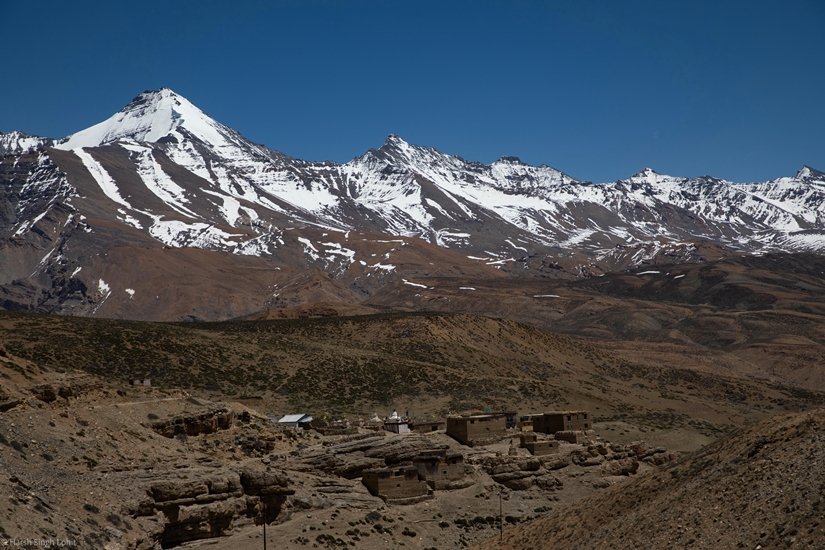 On Route Kibber Village
On Route Kibber Village
This young woman waits for her two village friends as they gather grass on the mountainside, and it will take them two hours to walk to their village with their load of Penmah grass. A sense of community yet pervades the Spiti village as everyone helps the other in constructing their home as well as in irrigation, weeding and harvesting. Labor is a part of life, not yet automated out. Of course, there are tensions, politics of power, and inequality in village relations. There is no ideal place and time in the past, however the village community is alive and well one that is absent in the alienated urban life. The stillness gets deeper roots.
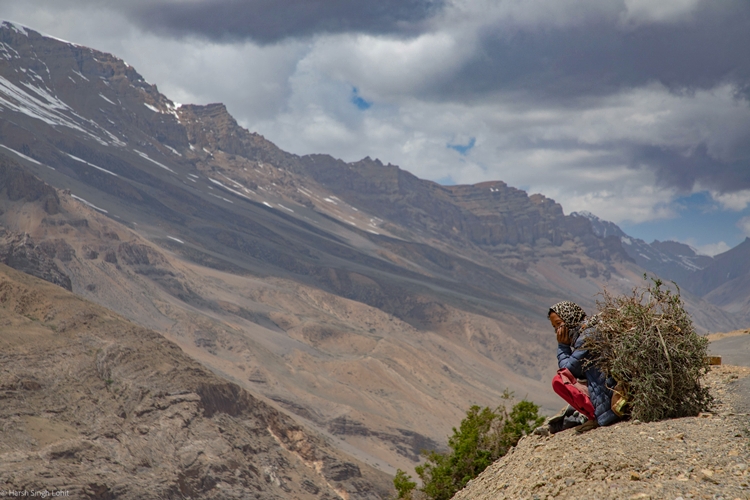 Carrying Penmah Grass for the Roof
Carrying Penmah Grass for the Roof
Dhangkar is the erstwhile capital of Spiti. The picturesque fort and Gompa (monastery) on top of the hill also houses a dungeon where the Nono (the local potentate) is said to have held prisoners. This ancient Gompa is much visited by tourists. We thus quickly sped away from the crowds but not before we explored its many low-ceilinged rooms and amazing Buddhist treasures of statues and wall paintings of multiple heavens, gods, and holy men of ages past.
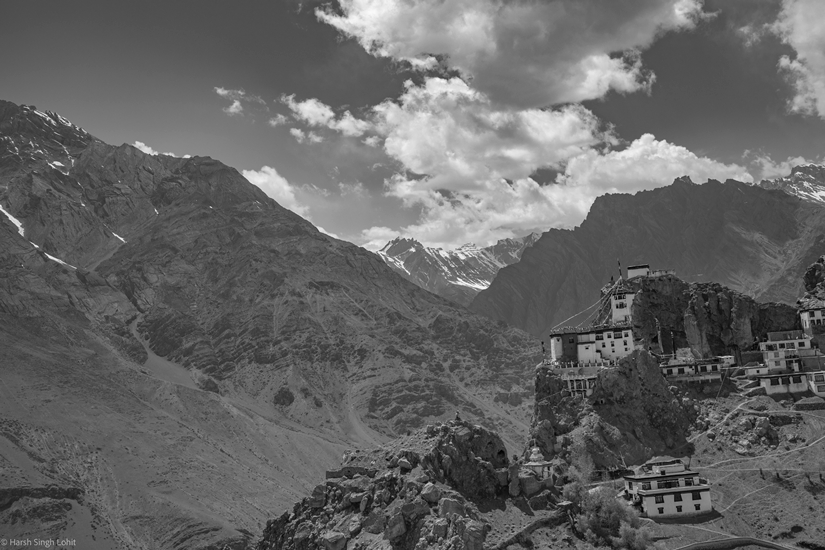 Dhangkar Gompa
Dhangkar Gompa
Tabo is an ancient village, its 10th century Gompa said to be next in sacredness for Tibetan Buddhists to the Thuling gompa in Tibet. The Gompa is extremely well preserved considering its 1,000 year history of active use as a place of worship and its mud construction and the temporariness it conveys. It hosts beautiful art painted in stunning natural colors from plants, powdered stone and mud. The Gompa is under severe threat due in part to the changes in weather and fragility due its age. We saw parts of the ancient walls where water had leaked (melting snow that leaked from the ancient roof, I conjectured, having seen this happen in my village home) and many precious wall paintings washed away. The village of Tabo is struggling with newfound wealth from tourism and recently planted fruit orchards. The same locally inappropriate modern homes, restaurants and hotels have spring up all over, terribly ugly compared to the ancient Gompa. Iron rods stick out from the roof, a sign of the building’s construction, in ever hopeful anticipation of being subsumed as a part of another floor and greater prosperity & well-being.
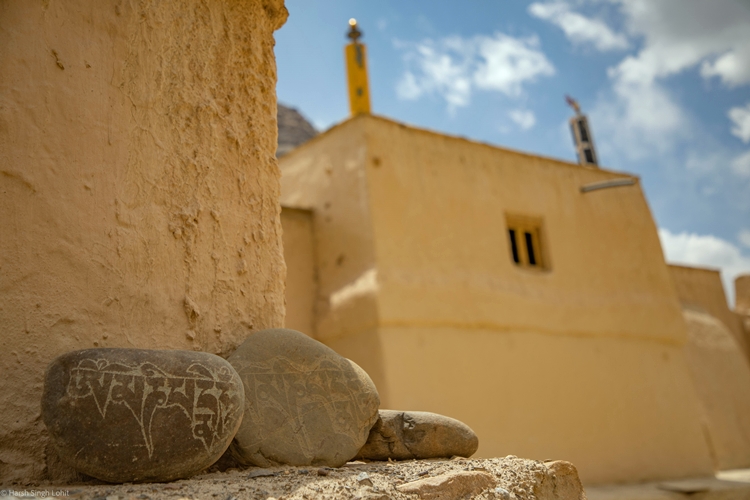 Mane Stones at Tabo Gompa
Mane Stones at Tabo Gompa
I must confess my limitation of not having understood, despite weak efforts over the decades, the complex ecosystem of the Tibetan Buddhist gods and ancient holy men. Neither do I remember their names and sequence of appearance in mythology. I have also often wondered how the teachings of Buddh - dealing with human suffering and death, of compassion towards all and living a moral life - make it through to the believers from deep below these heavy customs. Organised religion creates myths and onerous rituals to keep believers occupied and out of mischief. There comes a tipping point, it seems to me, when arcane customs and ancient myths become an end in themselves and religion dominates and becomes distanced from daily ethics. In many instances, aided by the stresses of modernity, humans are reduced to a level where hate rallies the faithful against the Other as an act of self-assertion. Ethics as the foundations of a non-denominational Dharma starts to make sense only after one recognises organised religions are about power, dominance, wealth and fame for the clergy. Religious institutions are remarkable similar to modern corporations. This is truer as the race for power becomes frenetic with digital technology.
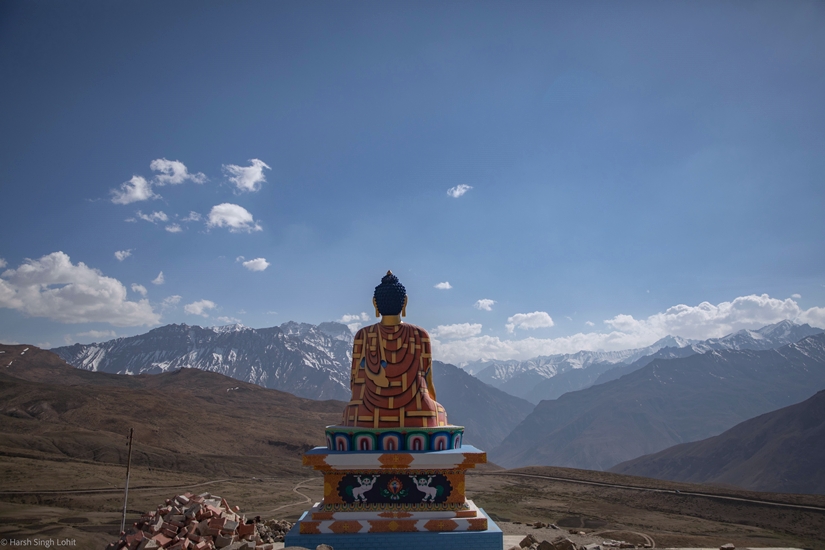 Langza village
Langza village
The current Dalai Lama is an exceptional human being and an unusually honest religious leader rooted in his peoples anguish of permanent exile. He seems the rare, ethical acharyas who fully understands the role of seemingly arcane rituals of his form of Tibetan Buddhism in these times of tremendous change. His talks on love, compassion and living a moral life strike a chord with people across beliefs, nationalities and religions. It is rare indeed to see a leader of society emulated and looked upto by so many as an ethical beacon.
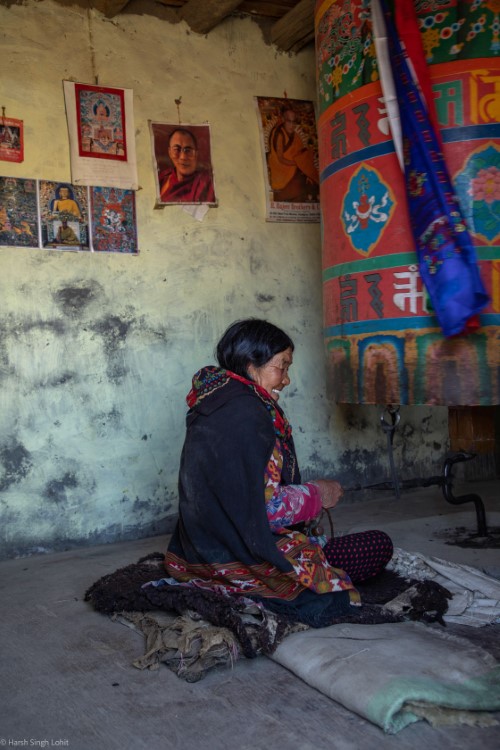 At a Prayer Wheel in Kibber Village
At a Prayer Wheel in Kibber Village
Global warming is local and real. Villagers shared stories of reduced snowfall in winter, lesser formation of glaciers and snow and ice in the cold months, and quicker melting of glaciers in summer due hotter temperatures. Extreme cold and warm events have increased, the weather has overall grown warmer and more prone to extremes. And so on it goes. Dharma can be defined as understanding Prakriti as an extension of oneself. One can think of the many living beings including animals, birds, plants and trees as the worldly manifestation of a diffused, Nirgun, god. All religions hold in their womb a respect and awe of Nature, its complexity not really comprehensible by human thought. That’s why, too, we see the rituals we do.
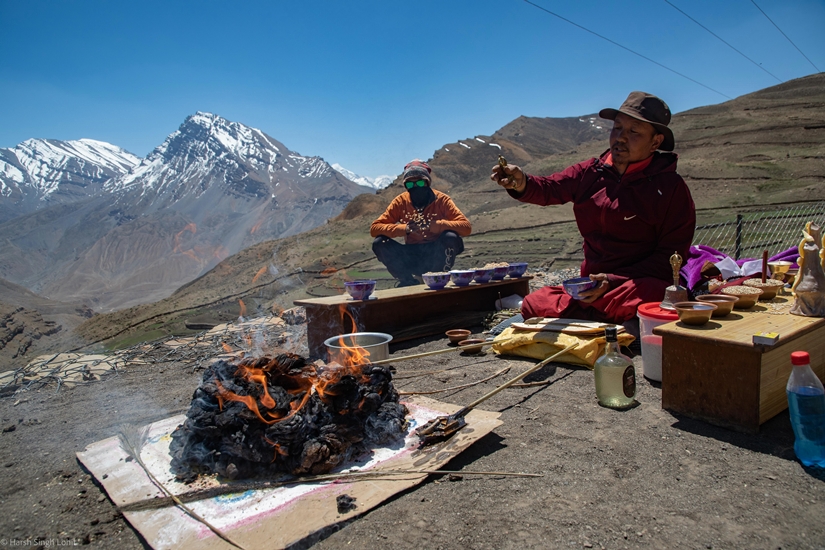 Lama Prays for Successful Sowing. Kibber village
Lama Prays for Successful Sowing. Kibber village
We travelled to Pin Valley to spend the day in Sangnam village with two young, energetic friends Soni and Karma at their homestay. The Pin Valley National Park is spread over 675 kilometers in a cold-desert ecology, even more remote and more beautiful than Spiti. We visited the Buddhist nunnery at Kungri where the sweetest Choumo (nuns) live, led by Karma’s sister. A sense of selfless service motivated Soni and Karman to setup an old age home – from their own funds - in Rewalsar town at a much warmer 6,000 feet in Kulu valley. For the period November to March, ageing villagers, many not able to look after themselves, are transported by these two ladies to Rewalsar from the below-freezing temperatures of in Pin valley. Service is love, and these two remind one of the many unsung everyday heroes who enable us believe in humanity in this time of disenchantment.
Aptly, the flowers were blooming and crops were being planted and the summer was glorious.
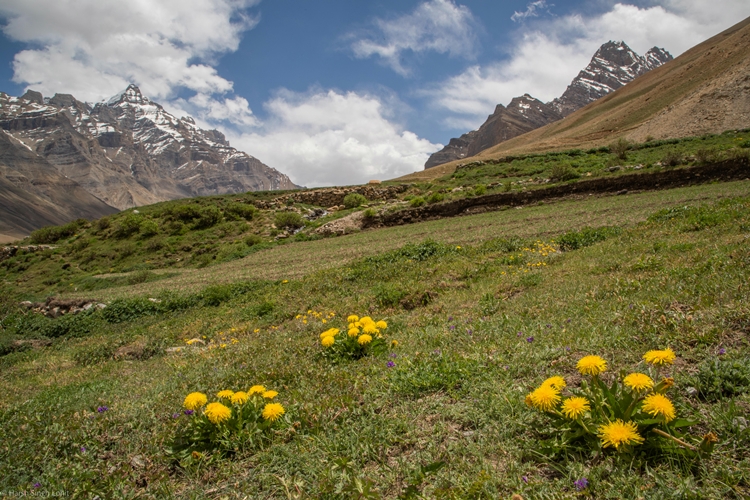 Pin Valley Summer
Pin Valley Summer
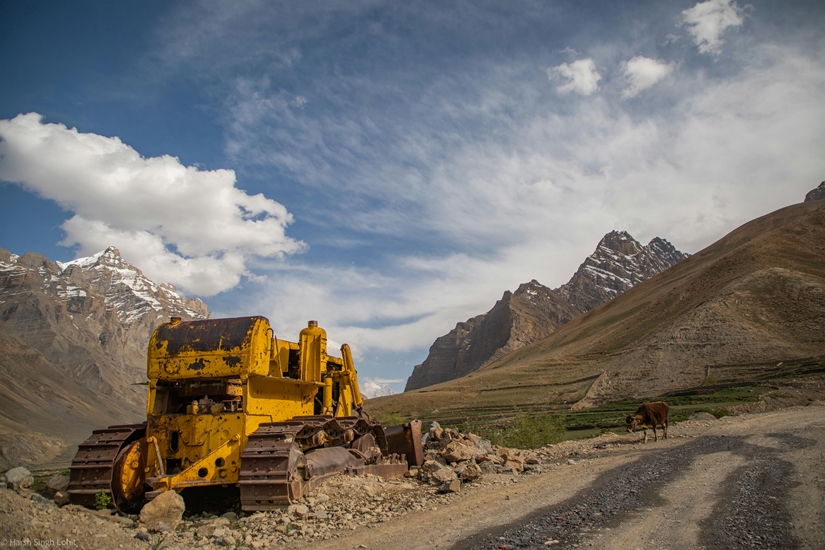
There was a lot to think on the gradual journey home to Gurgaon. We were sorry to see the last of Karanbir, his staff and his hospitality, intrepid Lobzang and her adopted daughter rescued from an early arranged marriage, Soni and Karma with their infectious enthusiasm and selfless actions, and the many hospitable men and women of Spiti we met. The vast natural and human heritage we experienced was a visual treat, refreshing memories of an earlier visit, and a yet earlier visit to Ladakh. The organic nature of the connect between the people and their environment is rare to see these days.
Society desires the removal of human poverty and inequality through economic development. Whether this actually happens, or development serves only to increase the prosperity of corporations and a thin sliver of society is obvious. What is also clear is that we primarily use monetary criteria to judge the prosperity of individuals, families and communities – just as economists use GDP growth as a marker of the nation’s progress. The move away from subsistence and barter to a market and money-dominated economy in the last 50 years in India has caused unprecedented change, obvious material benefits and enormous dislocation of all kinds. One gets what one measures, a truism one learns well, ironically, while running a business. When society does not measure quality of life through lived ethics, healthy relationships with humans and nature, a stable community life, clean housing and healthy food, clean air and water, stress-free livelihoods then we should not be surprised that increased material wealth is all that society gets. This development lies at the root of degradation of Prakriti in this upside down world in which I and you are both cause and effect.
